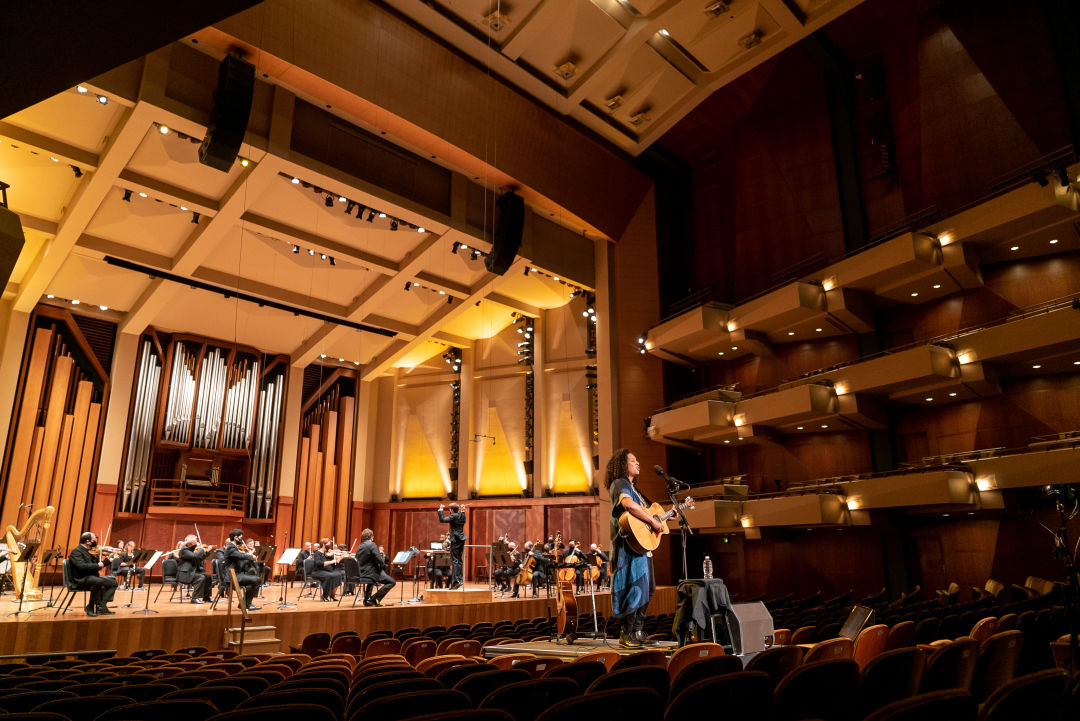
Before her last song backed by Seattle Symphony, folk singer Whitney Mongé paused and spoke in Benaroya Hall: “This has been an incredible opportunity, but also a very strange one.” Strange indeed: Rain poured down the image of her face, and to get a better look from my car in the second row, I had to wipe the condensation from the inside of my windshield with a blanket.
Of course, Seattle Symphony’s opening night concert on Saturday night was streamed from an empty hall. And a portion of that stream forked and flowed into Redmond’s Marymoor Park, where lines of cars parked in front of a big screen and tuned to an FM station synced to the video. Each time the orchestra finished a song, cars honked and flashed their high beams. A food truck served burgers and fries. Surely some champagne in some car illicitly popped. You could stream from home (as the rest of this season will be), but we’d gathered to make an event—sold out, as it was—of opening night.

Proper concerts should be one of the last things to return once Covid-19 restrictions lift. So the industry has tried different ways to imbue album releases, or even just shows, with a sense of happening. You’ve got the empty venue streams from places like the Nectar Lounge (better than a webcam in someone's bedroom, still aesthetically anemic). On Tuesday, Fleet Foxes released a new record, Shore. It streamed live in the morning with an album-long music video by Seattle-born director Kersti Jan Werdal. The music and images are what you should expect from the band: gorgeous and harmony-rich songs set to idyllic, naturalist scenes from the Northwest—blackberry picking, water flowing, someone reading in a sun-kissed grove.
An album film isn’t exactly new. (Beyonce’s been there plenty.) But since Robin Pecknold and company can’t return to the Showbox and Paramount for release shows, it’s nice—if not commensurate—to have images to attach to the songs. I almost wish it’d disappeared after the livestream. One of the reasons we’ve felt dislocated in time this year, I think, is that in-person events took place on the calendar, at an hour. The internet is mostly always.
Plenty of others have held drive-up concerts to jibe with Covid restrictions. The screen at Marymoor was better suited to a rainy concert, but still more peculiar. (I doubt Seattle Symphony hoped their culminating performance of Beethoven’s 7th would be heard through the factory sound system of my 1994 Subaru station wagon. But so it is.) Look at it one way—the traveling, the gathering, the temporal fact—and you’re a step closer to normal concert. Look at it another—the screen distant from the performance, you distant from the screen—and you’re twice removed. Which was it? I’m not sure. I didn’t leave with the satisfaction of an actual show and I'm not sure when I'd want to attend another, but as I told the friend who came with me, “It was nice to get out of the house.”
"still" - Google News
September 25, 2020 at 11:20PM
https://ift.tt/366fIDl
Can New Music Still Be an Event? - seattlemet.com
"still" - Google News
https://ift.tt/35pEmfO
https://ift.tt/2YsogAP
Bagikan Berita Ini














0 Response to "Can New Music Still Be an Event? - seattlemet.com"
Post a Comment